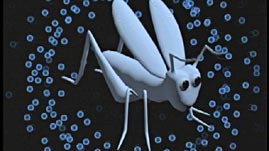Throughout our day, we receive an uninterrupted stream of sound messages such as car horns, dogs barking, and leaves rustling that communicate to us what's happening in the world around us. But just what is sound, and how do we sense and then process it?
Sound is a physical phenomenon. Though we cannot see sound travel, it does so in waves. Think of the air as the water in a pond. When you drop a pebble in still water, ripples spread outward from the spot in the water the pebble went in. Sound travels in the same way. When an object is struck, it begins to vibrate. As it vibrates, it rhythmically pushes and pulls the air molecules next to it. Each push creates a region of higher density and pressure in the air, and each pull creates a region of lower density and pressure. A wave of alternating high and low pressure regions forms, which moves outward and carries the sound's energy with it.
The main function of our ears is to catch sound waves and transfer them to nerves. Hearing is based entirely on physical movement. The process begins when sound waves enter the ear canal -- the space that leads from the opening of the ear to the eardrum. When sound waves reach the eardrum, it begins to vibrate. In turn, when the eardrum vibrates, the hammer, one of three bones in the middle ear, moves from side to side, pushing on the other two bones, called the anvil and stirrup, and causing them to vibrate. The vibrating stirrup stimulates hair cells in the inner ear, which send signals containing information about sound -- including its intensity and duration -- through nerves to the brain. The brain then interprets the sound's meaning.
Whether you hear a sound with a high or low pitch depends on how frequently the pressure waves hit the eardrum and cause it to vibrate. The faster the eardrum vibrates, the higher the pitch you hear; the slower it vibrates, the lower the pitch you hear.
Sometimes the brain filters out sounds so that you don't hear everything. If it didn't do this, you'd be awakened each time a car drove by in the street at night or the birds sang their morning songs.

 Loading Standards
Loading Standards Teachers' Domain is proud to be a Pathways portal to the National Science Digital Library.
Teachers' Domain is proud to be a Pathways portal to the National Science Digital Library.
